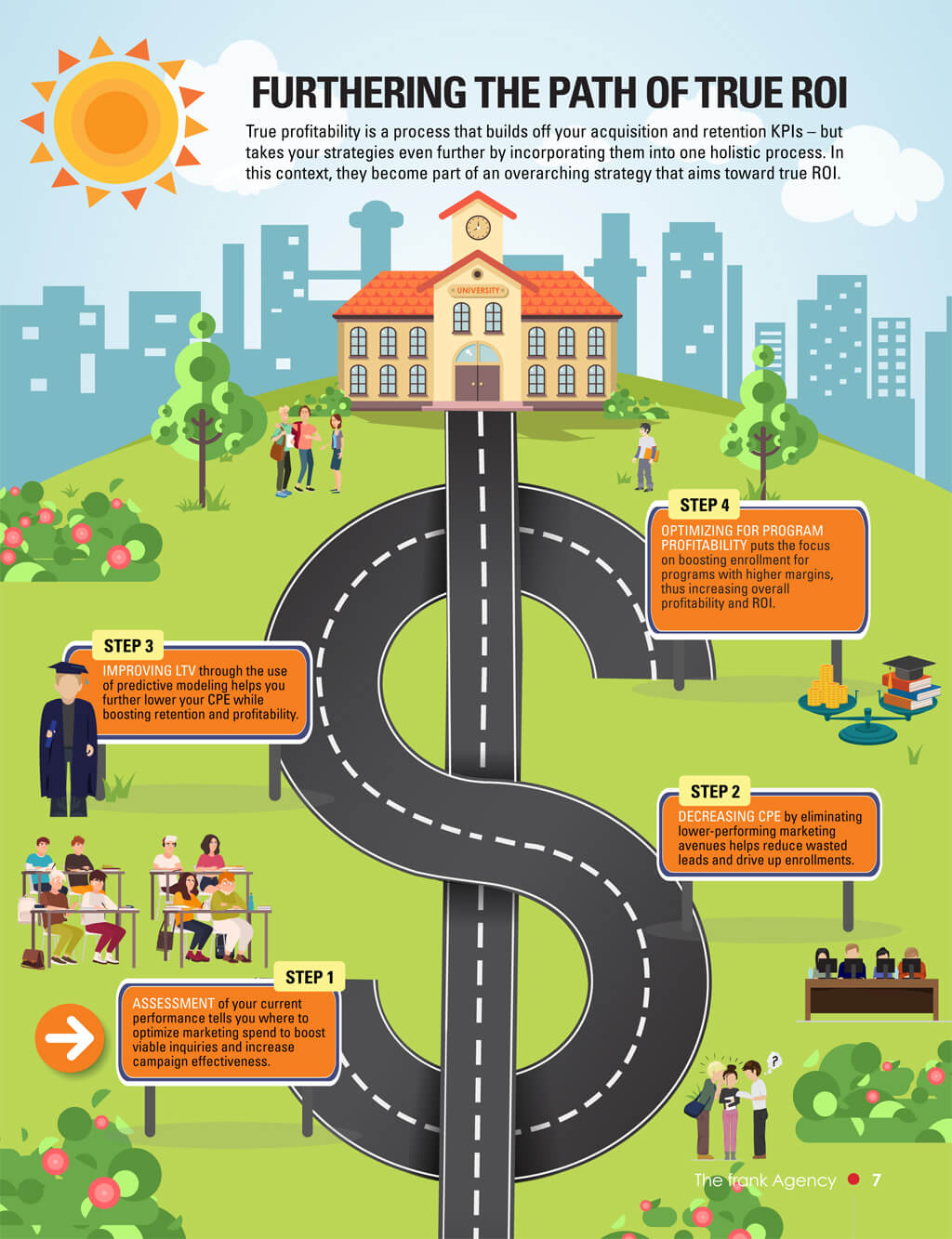Rethinking Old Models in Favor of True ROI
The first step to changing your outcomes is changing your thinking.
One of the most common problems in higher ed marketing is the almost myopic focus on cost-per-lead and cost-per-enrollment. Although these figures are crucial to knowing how your marketing budget is being spent, unfortunately they’re not indicative of your institution’s overall financial goals.
Most schools need to do “more with less” in the current environment. Going beyond basic CPL and CPE results provides a more holistic view, letting you see exactly how your marketing is performing down to the penny, and whether it’s truly doing its job of bringing in profitable enrollments.
But, in order to obtain this view, what first needs to happen is a change of mindset to one focused on optimizing each level of your marketing. And to change your mindset, there must be a break with the typical higher education marketing approach.
THE CONVENTIONAL ENROLLMENT PATH
Decreasing cost-per-lead
When it comes to optimizing marketing spend and determining ROI, lowering the cost-per-lead is often the first go-to approach – the thought being that by generating more leads at a lower cost, you cast a wider net that will yield more enrollments – and thus, more tuition revenue. However, this is not always the case.
Having a higher volume of lower cost leads doesn’t necessarily mean they will turn into enrollments. And, if they do turn into enrollments, they still may not yield a high lifetime value. So your CPL is not necessarily an accurate measure of true campaign success.
Decreasing cost-per-enrollment
Probably the most popular KPI, a bit deeper in the pipeline, is optimizing cost-per-enrollment (CPE). This method looks not only at CPL, but conversion to new enrolls. In many circumstances, this can require a higher investment on front-end CPL to attract those students most likely to convert.
There’s still a drawback to this model, however. Often students enroll, but don't stay with the program long enough to graduate. Attrition, as discussed more indepth on page 10, is a significant problem in higher education. When you’re paying to nurture inquiries and secure enrollments, only to see these students drop out, this equates to marketing dollars wasted. This challenge has resulted in yet a third model.
Optimizing for lifetime value
Since looking at success in terms of a particular CPL or CPE only shows a slice of how your marketing spend is paying off, a more holistic approach needs to be taken.
By determining your ROI based on the lifetime value of enrolled students, rather than merely the number of enrollments, you see a more complete picture of the net institutional gain. This is done by weighing the costs you spent to acquire the inquiry and enroll the student, versus the total value gained from their entire lifecycle as a student.
While this model obviously provides a much more comprehensive look at your marketing performance and your marketing’s profitability, it still doesn’t give a true ROI figure. In order to obtain this, there are far more factors to work into the model; when you take into account these variables, you can reach a total, detailed view of your actual net profitability.


DEVELOPING A TRUE ROI MODEL
The actual cost of having a student at your school is, itself, a variable. Consider this hypothetical scenario: a student who’s in an RN degree program costs your institution more than one who’s majoring in childhood education due to various factors (such as the highly credentialed faculty, additional course requirements, and so forth). Conversely, even though the RN student costs your institution more, they have a higher rate of retention than the average childhood-ed major. The ROI of the RN student must then be looked at in terms of this lifetime value, minus the costs associated with keeping the student, minus the costs to initially enroll them – then weighed against the ROI of your average childhood-ed major to show you which student is, in the long run, more profitable for your institution.
The profit margins of your programs are a considerable factor, both in the value of your students and in the net profitability of your institution. If you’re investing marketing dollars into specific programs because they tend to attract more students, but these programs have slimmer margins than your other programs, it may be time to reassess where your marketing spend is going.
You’re probably beginning to see why many schools don’t take the time or effort to dig into their institution’s true ROI: the system is incredibly nuanced, and requires you to look at broad, yet oft-neglected, characteristics like program profitability and costs of retention all the way down to more granular aspects, such as the effectiveness of the keywords you bid on in your paid ad campaigns. In short, it requires a complete change of mindset that is simultaneously comprehensive, and yet scrupulously attentive to details.
Each point in your multi-tier marketing campaigns, each aspect of your enrollment funnel, and each point in the student journey to graduation have costs and revenue associated with them. A true ROI model gathers all the data, weighing it carefully to show you a highly precise picture of your school’s net profitability.
With this picture comes power – the power that you gain from having a deep awareness of where your institution can improve. And armed with this knowledge, you can then optimize your marketing spend, tailoring it to those students and programs that will ultimately provide the most net revenue.
Now, lest this appear pragmatic, having such a mindset is the best way to mutually benefit both school and student. If your outlook is bent on reducing wasted marketing spend and boosting net profitability, you’ll have the funds to invest in your faculty, enhance your programs and credibility, and improve the student experience. And with these advancements at play, you create an institution as a whole that stands out from its peers as an excellent and preferable school option.

